This article needs additional citations for verification .(April 2014) |


A chamber pot is a portable toilet, meant for nocturnal use in the bedroom. It was common in many cultures before the advent of indoor plumbing and flushing toilets.
This article needs additional citations for verification .(April 2014) |


A chamber pot is a portable toilet, meant for nocturnal use in the bedroom. It was common in many cultures before the advent of indoor plumbing and flushing toilets.
"Chamber" is an older term for bedroom. The chamber pot is also known as a Jordan, [1] [2] a jerry, a guzunder, a po (possibly from French : pot de chambre), a potty pot, a potty, a thunder pot or a thunder mug. It was also known as a chamber utensil or bedroom ware.
Chamber pots were used in ancient Greece at least since the 6th century BC and were known under different names: ἀμίς (amis), [3] οὐράνη (ouranē) [4] and οὐρητρίς (ourētris, [5] from οὖρον - ouron, "urine" [6] ), σκωραμίς / (skōramis), χερνίβιον (chernibion). [7]
The introduction of indoor flush toilets started to displace chamber pots in the 19th century, but they remained common until the mid-20th century. [8] The alternative to using the chamber pot was a trip to the outhouse.
In China, the chamber pot (便壶 (biàn hú) was common. A wealthy salt merchant in the city of Yangzhou became the symbol of conspicuous excess when he commissioned a chamber pot made of gold which was so tall that he had to climb a ladder to use it. [9]

Chamber pots continue in use today [update] in areas lacking indoor plumbing.
In the Philippines, chamber pots are used as urinals and are known as arinola in most Philippine languages, such as Cebuano [10] and Tagalog.
In Korea, chamber pots are referred to as yogang (요강). They were used by people who did not have indoor plumbing to avoid the cold elements during the winter months.

The term "potty" is used when discussing the toilet with small children, such as during potty training.[ clarification needed ] It is also usually used to refer to the small, toilet-shaped devices made especially for potty training, which are similar to chamber pots. These "potties" are generally a large plastic bowl with an ergonomically designed back and front to protect against splashes. They may have a built-in handle or grasp at the back to allow easy emptying and a non-slip bottom to prevent the child from sliding while in use. Some are given bright colors, and others may feature gentle or unoffensive drawings or cartoon characters. In many cases they are used since it is difficult for children to maneuver themselves up onto the normal toilet; in addition the larger opening in the regular toilet is much too wide for a child to sit over comfortably and not fall in without some type of aid. Their size means they can be packed away in a bag for days out or when camping with young children, and can be placed near or under beds for sufferers of nocturia or some other form of incontinence.
A chamber pot might be disguised in a sort of chair (a close stool). It might be stored in a cabinet with doors to hide it; this sort of nightstand was known as a commode, hence the latter word came to mean "toilet" as well. For homes without these items of furniture, the chamber pot was stored under the bed.
The modern commode toilet and bedpan, used by bedbound or disabled persons, are variants of the chamber pot.
"The Crabfish" is a 17th-century folk song about what is most likely a common lobster, stored in a chamber pot by an unwise fisherman. The moral of the song is that one should look into a chamberpot before using it.
Philippine mythology recounts that giving newlyweds a chamberpot assures them of prosperity. President Elpidio Quirino, as part of a smear campaign against him, was falsely rumoured to possess a golden arinola. [11]
Thomas More in his satire Utopia had chamberpots made out of gold.

Greywater refers to domestic wastewater generated in households or office buildings from streams without fecal contamination, i.e., all streams except for the wastewater from toilets. Sources of greywater include sinks, showers, baths, washing machines or dishwashers. As greywater contains fewer pathogens than blackwater, it is generally safer to handle and easier to treat and reuse onsite for toilet flushing, landscape or crop irrigation, and other non-potable uses. Greywater may still have some pathogen content from laundering soiled clothing or cleaning the anal area in the shower or bath.

A bathroom, restroom or washroom is a room, typically in a home or other residential building, that contains either a bathtub or a shower. The inclusion of a sink is common. In parts of the world e.g. India, a toilet is typically included in the bathroom; in others, the toilet is typically given a dedicated room separate from the one allocated for personal hygiene activities. In the United States and Canada, the word "bathroom" is often used to refer to any room that contains a toilet, regardless of the inclusion of a bath or shower.
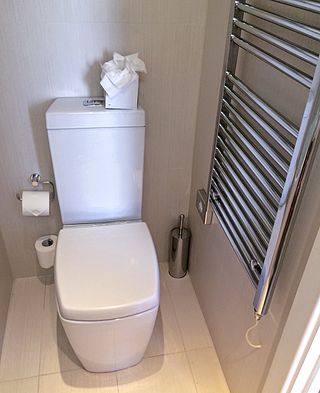
A flush toilet is a toilet that disposes of human waste by using the force of water to flush it through a drainpipe to another location for treatment, either nearby or at a communal facility, thus maintaining a separation between humans and their waste. Flush toilets can be designed for sitting or squatting, in the case of squat toilets. Most modern sewage treatment systems are also designed to process specially designed toilet paper. The opposite of a flush toilet is a dry toilet, which uses no water for flushing.

A bidet is a bowl or receptacle designed to be sat upon in order to wash a person's genitalia, perineum (taint), inner buttocks, and anus. The modern variety has a plumbed-in water supply and a drainage opening, and is thus a plumbing fixture subject to local hygiene regulations. The bidet is designed to promote personal hygiene and is used after defecation, and before and after sexual intercourse. It can also be used to wash feet, with or without filling it up with water. In several European countries, a bidet is now required by law to be present in every bathroom containing a toilet bowl. It was originally located in the bedroom, near the chamber-pot and the marital bed, but in modern times is located near the toilet bowl in the bathroom. Fixtures that combine a toilet seat with a washing facility include the electronic bidet.

A nightstand, alternatively night table, bedside table, daystand or bedside cabinet, is a small table or cabinet designed to stand beside a bed or elsewhere in a bedroom. Modern nightstands are usually small bedside tables, often with one or sometimes more drawers and/or shelves and less commonly with a small door. They are often used to support items that might be useful during the night, such as a table lamp, reading matter, cell phone, eyeglasses, tissues, a drink, or medication.

A bedroom or bedchamber is a room situated within a residential or accommodation unit characterised by its usage for sleeping. A typical western bedroom contains as bedroom furniture one or two beds, a clothes closet, and bedside table and dressing table, both of which usually contain drawers. Except in bungalows, ranch style homes, ground floor apartments, or one-storey motels, bedrooms are usually on one of the floors of a dwelling that is above ground level. Beds range from a crib for an infant; a single or twin bed for a toddler, child, teenager or single adult; to bigger sizes like a full, double, queen, king or California king). Beds and bedrooms are often devised to create barriers to insects and vermin, especially mosquitoes, and to dampen or contain light or noise to aid sleep and privacy.

Toilet training is the process of training someone, particularly a toddler or infant, to use the toilet for urination and defecation. Attitudes toward training in recent history have fluctuated substantially, and may vary across cultures and according to demographics. Many of the contemporary approaches to toilet training favor a behaviouralism- and cognitive psychology-based approach.

Garderobe is a historic term for a room in a medieval castle. The Oxford English Dictionary gives as its first meaning a store-room for valuables, but also acknowledges "by extension, a private room, a bed-chamber; also a privy".

A portable or mobile toilet is any type of toilet that can be moved around, some by one person, some by mechanical equipment such as a truck and crane. Most types do not require any pre-existing services or infrastructure, such as sewerage, and are completely self-contained. The portable toilet is used in a variety of situations, for example in urban slums of developing countries, at festivals, for camping, on boats, on construction sites, and at film locations and large outdoor gatherings where there are no other facilities. Most portable toilets are unisex single units with privacy ensured by a simple lock on the door. Some portable toilets are small molded plastic or fiberglass portable rooms with a lockable door and a receptacle to catch the human excreta in a container.

A commode is any of many pieces of furniture. The Oxford English Dictionary has multiple meanings of "commode". The first relevant definition reads: "A piece of furniture with drawers and shelves; in the bedroom, a sort of elaborate chest of drawers ; in the drawing room, a large kind of chiffonier." The drawing room is itself a term for a formal reception room, and a chiffonier is, in this sense, a small sideboard dating from the early 19th century.
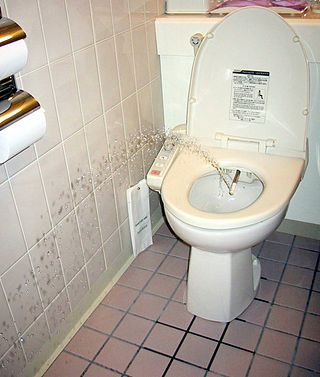
Toilets in Japan are sometimes designed more elaborately than toilets commonly seen in other developed nations. European toilets occasionally have a separate bidet whilst Japan combines an electronic bidet with the toilet. The current state of the art for Western-style toilets in Japan is the bidet toilet, which as of March 2016 is installed in 81% of Japanese households. In Japan, these bidets are commonly called washlets, a brand name of Toto Ltd., and they may include many advanced features rarely seen outside of Asia. The basic feature set commonly found on washlets consists of anal hygiene, bidet washing, seat warming, and deodorization.

A composting toilet is a type of dry toilet that treats human waste by a biological process called composting. This process leads to the decomposition of organic matter and turns human waste into compost-like material. Composting is carried out by microorganisms under controlled aerobic conditions. Most composting toilets use no water for flushing and are therefore called "dry toilets".
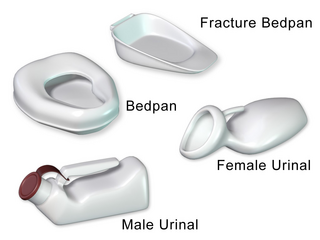
A bedpan or bed pan is a device used as a receptacle for the urine and/or feces of a person who is confined to a bed and therefore not able to use a toilet or chamber pot.
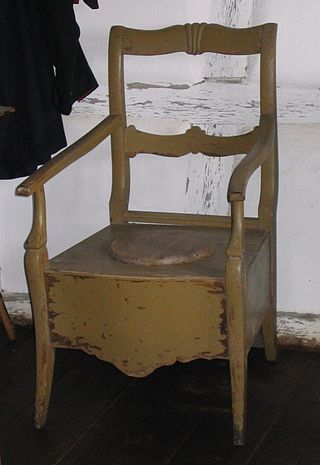
A close stool was an early type of portable toilet, made in the shape of a cabinet or box at sitting height with an opening in the top. The external structure contained a pewter or earthenware chamberpot to receive the user's excrement and urine when they sat on it; this was normally covered (closed) by a folding lid. "Stool" has two relevant meanings: as a type of seat and as human feces. Close stools were used from the Middle Ages until the introduction of the indoor flush toilet.

A toilet is a piece of sanitary hardware that collects human urine and feces, and sometimes toilet paper, usually for disposal. Flush toilets use water, while dry or non-flush toilets do not. They can be designed for a sitting position popular in Europe and North America with a toilet seat, with additional considerations for those with disabilities, or for a squatting posture more popular in Asia, known as a squat toilet. In urban areas, flush toilets are usually connected to a sewer system; in isolated areas, to a septic tank. The waste is known as blackwater and the combined effluent, including other sources, is sewage. Dry toilets are connected to a pit, removable container, composting chamber, or other storage and treatment device, including urine diversion with a urine-diverting toilet.

A potty chair, or simply a potty, is a proportionately small chair or enclosure with an opening for seating very young children to urinate and defecate. It is a variant of the close stool which was used by adults before the widespread adoption of water flushed toilets. There are a variety of designs, some placed directly over the toilet called "Toilet Training Seats" so the egested fecal material drops directly into the toilet bowl thereby eliminating manual removal and disposal of the said waste from a receptacle beneath the hole which is often a bag or receptacle similar to a chamber pot. Potty chairs are used during potty training, a.k.a. toilet training. These are very useful for young babies.
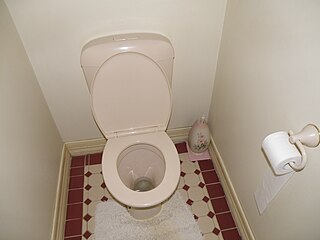
A toilet is a small room used for privately accessing the sanitation fixture (toilet) for urination and defecation. Toilet rooms often include a sink (basin) with soap/handwash for handwashing, as this is important for personal hygiene. These rooms are typically referred to in North America as half-bathrooms in a private residence.
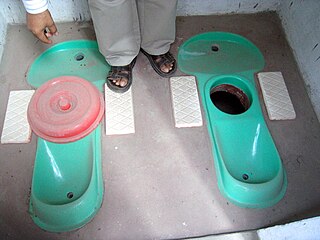
The Sulabh International Museum of Toilets in Delhi is run by the Sulabh International, dedicated to the global history of sanitation and toilets. According to Time magazine, the museum is one of the weirdest museums among the "10 museums around the world that are anything but mundane". It was established in 1992 by Dr. Bindeshwar Pathak, a social activist, founder of Sulabh Sanitation and Social Reform Movement, recipient of national and international awards including the Stockholm Water Prize in 2009. His objective in establishing this museum was to highlight the need to address the problems of the sanitation sector in the country, considering the efforts made in various parts of the world in this field since the third millennium BCE.
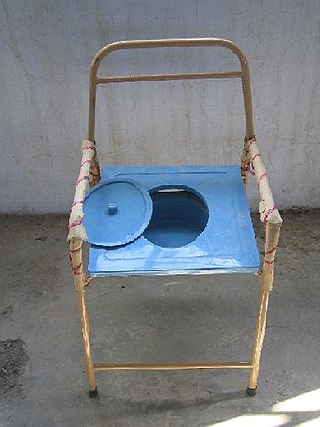
A commode chair, known in British English simply as a commode, is a type of chair used by someone who needs help going to the toilet due to illness, injury or disability. A commode chair sometimes has wheels to allow easy transport to the bathroom or shower. Most commode chairs have a removable pail and flip-back armrests.
Elpidio Quirino, the President of the Philippines from 1948 to 1953, was alleged to have own a golden arinola and was subject to controversy.